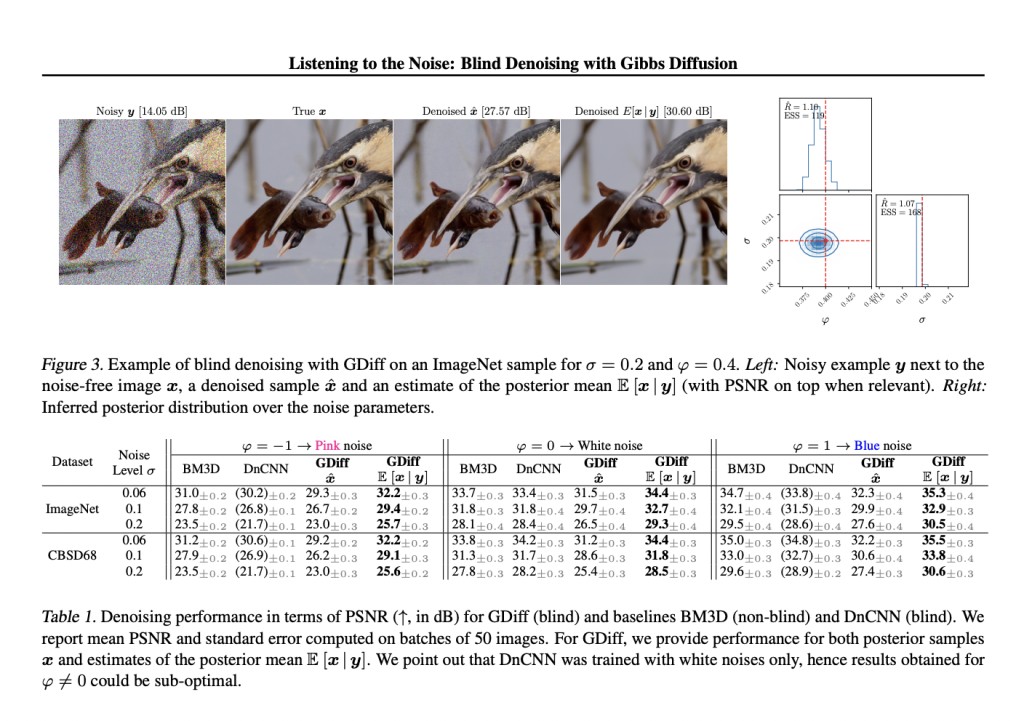With the recent advancement of deep generative models, the challenge of denoising has also become apparent. Diffusion models are trained and designed similarly to denoisers, and their modeled distributions agree with denoising priors when applied in a Bayesian setting. However, blind denoising, when these parameters are unknown, is difficult since conventional diffusion-based denoising techniques require previous knowledge of the noise level and covariance.
In a recent study, a team of researchers from Ecole Polytechnique, Institut Polytechnique de Paris and Flatiron Institute proposed a unique approach called Gibbs Diffusion (GDiff) to overcome the limitations. This approach allows posterior sampling of the noise parameters in addition to the signal parameters simultaneously. The creation of a Gibbs method specifically designed for situations involving arbitrary parametric Gaussian noise is the main feature here. The two kinds of sample phases that the algorithm uses in alternation are as follows.
Conditional Diffusion Model Sampling: In this stage, a trained diffusion model is used to map the signal’s previous distribution to a family of noise distributions. This model considers the noise’s peculiarities and helps in signal inference.
Monte Carlo Sampling: Inferring the noise parameters is the main goal of the Monte Carlo Sampling stage. The approach can estimate the parameters that characterize the noise distribution by using a Monte Carlo sampler.
The team has shared that the theoretical evaluation of the Gibbs Diffusion method quantifies the flaws in the Gibbs stationary distribution resulting from the diffusion model. It also offers recommendations for diagnostic applications. Two applications have been highlighted to illustrate the effectiveness of this method.
Blind Denoising of Natural Images: In this application, colored noise is used to blur images, but its amplitude and spectral index are unknown. The GDiff approach recovers the clean image and characterizes the noise at the same time, which allows it to successfully perform the blind denoising problem.
Cosmology problem: The second application deals with data processing related to the cosmic microwave background (CMB). Within this framework, constraining models of the universe’s evolution are achieved through Bayesian inference of the noise parameters. The GDiff approach can be used to enhance comprehension of cosmological models by inferring the noise parameters.
The team has shared their primary contributions, which are as follows.
To address the difficulties of modeling the prior distribution based on samples​ and sampling the posterior, the team has introduced Gibbs Diffusion (GDiff), a unique approach to blind denoising.
The team has provided a solid theoretical framework for GDiff by establishing requirements for the presence of stationary distribution within the method and quantifying the propagation of inference mistakes.
The effectiveness of the approach has been showcased in two domains: cosmology, where it supports the Bayesian inference of noise parameters to constrain models of the Universe’s evolution, and blind denoising of natural photos with arbitrary colored noise, where GDiff beats traditional baselines.
In conclusion, Gibbs Diffusion is a major breakthrough in denoising that makes it possible to recover signals more thoroughly and precisely in situations where noise parameters are unknown.
Check out the Paper and GitHub. All credit for this research goes to the researchers of this project. Also, don’t forget to follow us on Twitter.Â
Join our Telegram Channel and LinkedIn Group.
If you like our work, you will love our newsletter..
Don’t Forget to join our 45k+ ML SubReddit
The post Gibbs Diffusion (GDiff): A New Bayesian Blind Denoising Method with Applications in Image Denoising and Cosmology appeared first on MarkTechPost.
Source: Read MoreÂ

